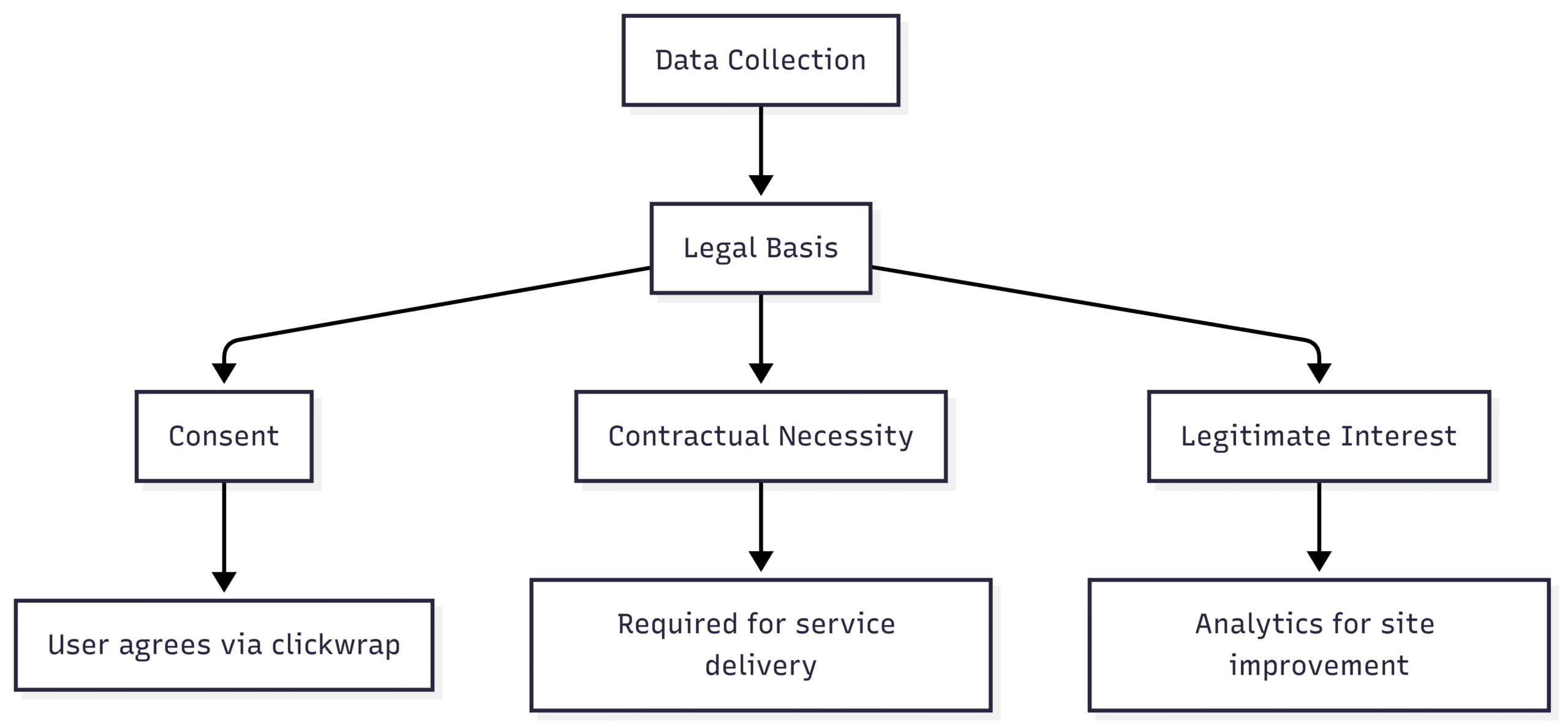How To Write a Privacy Policy in 9 Easy Steps
Learn how to write a privacy policy in 9 easy steps. Ensure compliance with GDPR, CCPA, and more with our detailed guide.
A privacy policy is a critical legal document for any website or app that collects personal information. It informs users about how their data is collected, used, shared, and protected, ensuring transparency and compliance with global data privacy laws. Crafting a comprehensive, user-friendly, and legally sound privacy policy is essential to build trust with users and avoid legal repercussions. This guide outlines nine straightforward steps to create an effective privacy policy, ensuring compliance with regulations like the General Data Protection Regulation (GDPR), the California Consumer Privacy Act (CCPA), and others. We’ll also cover key clauses, best practices, and tips for displaying your policy to maximize accessibility and trust.
Why a Privacy Policy Matters
A privacy policy serves multiple purposes. It’s a legal requirement under various data privacy laws, ensuring users understand their rights and how their personal information is handled. Beyond compliance, a well-crafted policy fosters trust, with 88% of users more likely to share data with companies they trust, according to PwC. Conversely, 76% of users believe companies must do more to protect their data, per the Global Consumer State of Mind Report 2021. A transparent policy can prevent users from abandoning your platform, as 33% have terminated relationships with companies over data privacy concerns, according to Cisco.
Failure to comply with regulations like GDPR or CCPA can result in hefty fines—up to €20 million or 4% of annual global turnover for GDPR violations. A clear, accessible privacy policy mitigates these risks while enhancing user confidence.
Step-by-Step Guide to Writing a Privacy Policy
Step 1: Understand Applicable Data Privacy Laws
Before drafting your privacy policy, identify the data privacy laws that apply to your business. These vary based on your location, user base, and operations. Key regulations include:
- GDPR (EU): Requires explicit consent, detailed data collection disclosures, and user rights like access and deletion.
- CCPA (California, USA): Mandates disclosures about data collection, sharing, and user rights, including “Do Not Sell or Share My Personal Information” links.
- CalOPPA (California, USA): Requires a policy with an effective date, data collection details, and opt-out options.
- CDPA (Virginia, USA): Demands disclosures on data processing, sharing, and user rights.
- PIPEDA (Canada): Emphasizes consent and transparency in data collection practices.
Research these laws thoroughly, focusing on requirements for data collection, user rights, and consent mechanisms. For example, GDPR requires a legal basis for data collection, while CCPA mandates annual policy updates. Non-compliance can lead to significant penalties, so consult legal resources or experts if needed.
Step 2: Conduct a Privacy Audit
Perform a comprehensive audit of your website or app to identify all personal information collected. This includes:
- Directly Collected Data: Names, email addresses, payment details, or user inputs via forms.
- Indirectly Collected Data: IP addresses, browsing activity, or data gathered through cookies and trackers.
Use tools like cookie scanners or analytics platforms to map data collection points. Document every instance, as omitting data types can violate laws like GDPR or CCPA, which define personal information broadly. For instance, sensitive personal information (e.g., financial data, health information) faces stricter regulations under CCPA.
Step 3: Categorize Personal Information
Organize collected data into categories based on applicable laws. For example:
| Data Category | Examples | Regulation |
|---|---|---|
| Personal Information | Name, email, phone number | GDPR, CCPA |
| Sensitive Personal Information | Financial data, health information | CCPA, CDPA |
| Tracking Data | Cookies, IP addresses, device IDs | GDPR, ePrivacy |
This categorization ensures compliance with laws that impose stricter rules on sensitive data. For instance, CCPA requires explicit disclosures for sensitive personal information, while GDPR mandates a legal basis for each category.
Step 4: Define the Legal Basis for Data Collection
Under GDPR, you must justify why you collect each data type. Common legal bases include:
- Consent: Users explicitly agree to data collection.
- Contractual Necessity: Data is required to fulfill a service (e.g., delivery addresses for e-commerce).
- Legitimate Interest: Data use benefits your business without harming users (e.g., analytics for site improvement).
Document the legal basis for each data category in your policy. For example, Spotify’s GDPR-compliant policy uses a table to outline data types and their purposes, enhancing clarity.

Step 5: Explain How Data Is Collected
Clearly describe how you collect data, whether through:
- Direct Methods: Forms, account creation, or payment screens.
- Indirect Methods: Cookies, third-party analytics (e.g., Google Analytics), or tracking pixels.
Use simple language to ensure accessibility. For example, Disney’s privacy policy clearly explains data collection via forms and cookies, avoiding technical jargon. This transparency aligns with GDPR and CCPA requirements for clear disclosures.
Step 6: Detail Data Usage and Sharing
Explain how you use collected data, such as for:
- Providing services (e.g., processing orders).
- Marketing (e.g., personalized ads).
- Analytics (e.g., improving user experience).
If data is shared or sold to third parties (e.g., affiliates, service providers), disclose this explicitly. CCPA and GDPR require detailed sharing disclosures. For instance, Google’s policy uses bullet points to list data uses, making it easy to scan. Include a table like this:
| Data Type | Purpose | Shared With |
|---|---|---|
| Email Address | Marketing, account management | Email service providers |
| Payment Information | Order processing | Payment processors |
| Browsing Activity | Analytics | Third-party analytics |
Step 7: Outline Safety and Security Practices
Describe how you protect user data, including:
- Encryption: Securing data during transmission and storage.
- Access Controls: Limiting data access to authorized personnel.
- Data Retention: Specifying how long data is stored (e.g., GDPR mandates minimal retention).
Visa’s privacy policy, for example, details encryption and access controls, reassuring users about data security. This is critical under GDPR and CCPA, which hold businesses accountable for data breaches.
Step 8: Address Privacy Policy Updates
Inform users how you’ll notify them of policy changes, such as via email or website banners. CCPA requires annual updates, while GDPR mandates clear communication of changes. Instagram’s policy, for instance, outlines its update process concisely, ensuring transparency.
Step 9: Include Additional Clauses
Add clauses specific to your business or legal requirements, such as:
- Children’s Privacy: Address COPPA compliance if targeting users under 13. Disney links to a separate children’s privacy policy for clarity.
- International Data Transfers: Disclose data transfers outside the EU, as required by GDPR. Spotify’s policy includes a straightforward clause on this.
- Business Transfers: Note that data may transfer to new owners if your business is sold, as seen in Visa’s policy.
- Contact Information: Provide a clear contact point (e.g., email, phone) for privacy inquiries, as Spotify does.
Crafting an Effective Privacy Policy Outline
Before writing, create an outline to organize your policy. Consider these steps:
- Choose a Format: Use a traditional structure with sections or an FAQ-style for accessibility.
- Prioritize Key Information: Place critical clauses (e.g., data collection, user rights) near the top.
- Ensure Readability: Use clear fonts (e.g., Arial, 12pt) and avoid dense text blocks.
- Use Simple Language: Avoid legalese to comply with laws like GDPR, which prioritize clarity.
- Verify Compliance: Cross-check all clauses against applicable regulations.
Here’s a sample outline in format:

Key Clauses to Include
Introduction
Introduce your company, the policy’s scope, and key terms. Be transparent to set expectations, as Spotify does by clearly defining its audience and terms.
Personal Information Collected
List all data types collected, such as names, emails, or IP addresses. Apple’s policy provides a detailed list, ensuring compliance with GDPR and CCPA.
Data Collection Methods
Explain direct (e.g., forms) and indirect (e.g., cookies) methods. Disney’s policy is a model for clear, user-friendly language.
Legal Basis for Collection
Justify data collection under GDPR or similar laws. Spotify’s table format is effective for clarity.
Data Usage
Detail how data is used (e.g., service delivery, marketing). Apple’s bullet-point list enhances readability.
Data Sharing
Disclose third-party sharing, as Google does with concise explanations.
Children’s Privacy
Address COPPA requirements, even if your platform isn’t child-focused. Disney links to a separate children’s policy for compliance.
User Rights
Outline rights like access, deletion, or correction, as required by GDPR and CCPA. Google’s policy provides a clear example.
Data Access and Control
Explain how users can manage their data, including DSAR forms, as Uber does.
Security Practices
Detail encryption, access controls, and retention policies, as Visa does.
Data Retention
Specify retention periods, as Google does, to comply with GDPR and CDPA.
Cookies and Trackers
Mention cookie usage and link to a separate cookie policy, as Uber does.
Policy Updates
Describe the update process, as Instagram does, to meet CCPA requirements.
Links to Other Policies
Link to terms and conditions or cookie policies, as Spotify does, for accessibility.
International Data Transfers
Address EU data transfer rules, as Spotify does, for GDPR compliance.
Business Transfers
Note potential data transfers during business sales, as Visa does.
Contact Information
Provide clear contact details, as Spotify does, for user inquiries.
What to Avoid in Your Privacy Policy
- Confusing Language: Avoid jargon or legalese to ensure accessibility, as required by GDPR and CCPA.
- Omitting Details: Disclose all data practices to avoid legal risks and maintain trust.
- Neglecting Updates: Review your policy annually (per CCPA) to reflect changes in practices or laws.
- Copying Others’ Policies: Plagiarism risks legal issues and misrepresents your practices. Use templates or generators instead.
Tips for an Outstanding Privacy Policy
Make It Easy to Agree To
Use clickwrap consent (e.g., checkboxes) for GDPR compliance, as American Eagle Outfitters does. Provide opt-out options, like Disney’s “Do Not Sell” link, for CCPA compliance.
Ensure Readability
Use clear, concise language. Paraphrase complex terms, but verify accuracy manually rather than relying solely on AI tools.
Avoid Copying
Use templates or generators to avoid plagiarism and ensure your policy reflects your practices.
Set Clear Expectations
Explain why data collection benefits users (e.g., personalized services), as 80% of users are open to sharing data for personalization, per Vision Critical.
Match Your Brand’s Voice
Align the policy’s tone with your brand while maintaining professionalism and compliance.
Be Honest
Transparency builds trust. Avoid false promises about data use or security.
Displaying Your Privacy Policy
Place your policy in accessible locations:
- Website/App Footer: Tesco’s footer link ensures constant visibility.
- Account Creation Page: Spotify links its policy during sign-up, informing users before data collection.
- Payment Screens: Best Buy includes a policy link on payment pages, where data collection occurs.
- Privacy Center: Spotify’s privacy center consolidates all legal agreements for easy access.
Consent and Compliance
Obtain explicit consent via clickwrap methods, as required by GDPR, or provide opt-out links for CCPA compliance. Honor browser-based preferences (e.g., Do Not Track) to align with CalOPPA.
Privacy Policy Solutions
Choose the best method to create your policy:
- Managed Solutions: Tools like privacy policy generators create compliant policies quickly by asking business-specific questions.
- Templates: Free templates offer customizable clauses vetted for compliance with GDPR, CCPA, and more.
- DIY Approach: Writing your own policy is possible but requires legal expertise to ensure compliance.
Conclusion
A well-crafted privacy policy is both a legal necessity and a trust-building tool. By following these nine steps—understanding laws, auditing data, categorizing information, justifying collection, explaining methods and usage, detailing security, addressing updates, and including relevant clauses—you can create a compliant, user-friendly policy. Display it prominently on your platform and ensure clear consent mechanisms. For simplicity, consider using a vetted template or generator to streamline the process while ensuring compliance with global regulations like GDPR, CCPA, CalOPPA, CDPA, and PIPEDA.
Please share these How To Write a Privacy Policy in 9 Easy Steps with your friends and do a comment below about your feedback.
We will meet you on next article.
Until you can read, How to Make Cooking Videos Online in 5 Easy Steps






